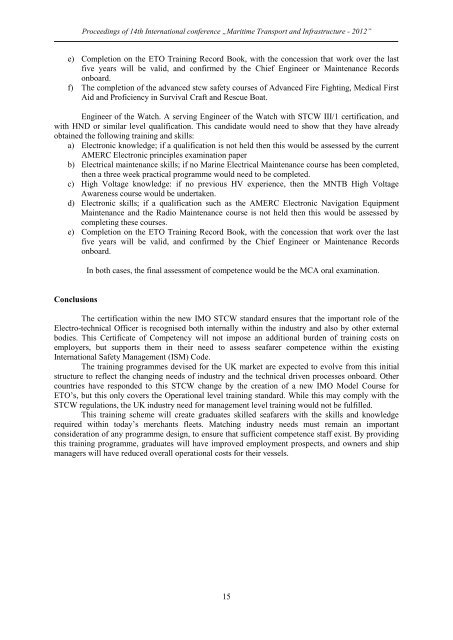14. starptautiskÄ konference 2012 - Latvijas JÅ«ras akadÄmija
14. starptautiskÄ konference 2012 - Latvijas JÅ«ras akadÄmija
14. starptautiskÄ konference 2012 - Latvijas JÅ«ras akadÄmija
Create successful ePaper yourself
Turn your PDF publications into a flip-book with our unique Google optimized e-Paper software.
Proceedings of 14th International conference „Maritime Transport and Infrastructure - <strong>2012</strong>”e) Completion on the ETO Training Record Book, with the concession that work over the lastfive years will be valid, and confirmed by the Chief Engineer or Maintenance Recordsonboard.f) The completion of the advanced stcw safety courses of Advanced Fire Fighting, Medical FirstAid and Proficiency in Survival Craft and Rescue Boat.Engineer of the Watch. A serving Engineer of the Watch with STCW III/1 certification, andwith HND or similar level qualification. This candidate would need to show that they have alreadyobtained the following training and skills:a) Electronic knowledge; if a qualification is not held then this would be assessed by the currentAMERC Electronic principles examination paperb) Electrical maintenance skills; if no Marine Electrical Maintenance course has been completed,then a three week practical programme would need to be completed.c) High Voltage knowledge: if no previous HV experience, then the MNTB High VoltageAwareness course would be undertaken.d) Electronic skills; if a qualification such as the AMERC Electronic Navigation EquipmentMaintenance and the Radio Maintenance course is not held then this would be assessed bycompleting these courses.e) Completion on the ETO Training Record Book, with the concession that work over the lastfive years will be valid, and confirmed by the Chief Engineer or Maintenance Recordsonboard.In both cases, the final assessment of competence would be the MCA oral examination.ConclusionsThe certification within the new IMO STCW standard ensures that the important role of theElectro-technical Officer is recognised both internally within the industry and also by other externalbodies. This Certificate of Competency will not impose an additional burden of training costs onemployers, but supports them in their need to assess seafarer competence within the existingInternational Safety Management (ISM) Code.The training programmes devised for the UK market are expected to evolve from this initialstructure to reflect the changing needs of industry and the technical driven processes onboard. Othercountries have responded to this STCW change by the creation of a new IMO Model Course forETO’s, but this only covers the Operational level training standard. While this may comply with theSTCW regulations, the UK industry need for management level training would not be fulfilled.This training scheme will create graduates skilled seafarers with the skills and knowledgerequired within today’s merchants fleets. Matching industry needs must remain an importantconsideration of any programme design, to ensure that sufficient competence staff exist. By providingthis training programme, graduates will have improved employment prospects, and owners and shipmanagers will have reduced overall operational costs for their vessels.15
















